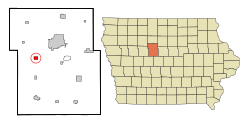Moorland, Iowa facts for kids
Quick facts for kids
Moorland, Iowa
|
|
|---|---|

Location of Moorland, Iowa
|
|
| Country | |
| State | |
| County | Webster |
| Area | |
| • Total | 1.49 sq mi (3.86 km2) |
| • Land | 1.49 sq mi (3.86 km2) |
| • Water | 0.00 sq mi (0.00 km2) |
| Elevation | 1,152 ft (351 m) |
| Population
(2020)
|
|
| • Total | 168 |
| • Density | 112.83/sq mi (43.56/km2) |
| Time zone | UTC-6 (Central (CST)) |
| • Summer (DST) | UTC-5 (CDT) |
| ZIP code |
50566
|
| Area code(s) | 515 |
| FIPS code | 19-53895 |
| GNIS feature ID | 0459218 |
Moorland is a small and friendly town. It is located in Webster County, Iowa, in the United States. In 2020, about 168 people called Moorland home.
Contents
Where is Moorland?
Moorland is located in the state of Iowa. You can find it at these coordinates: 42°26′32″N 94°17′37″W / 42.44222°N 94.29361°W. It's a small place, covering about 1.48 square miles (3.86 square kilometers). This entire area is land, so there are no large lakes or rivers within the town limits.
How Many People Live in Moorland?
Moorland's population has changed over the years. Here's a quick look at how many people have lived there during different census years:
| Historical populations | ||
|---|---|---|
| Year | Pop. | ±% |
| 1910 | 137 | — |
| 1920 | 181 | +32.1% |
| 1930 | 179 | −1.1% |
| 1940 | 215 | +20.1% |
| 1950 | 248 | +15.3% |
| 1960 | 281 | +13.3% |
| 1970 | 269 | −4.3% |
| 1980 | 257 | −4.5% |
| 1990 | 209 | −18.7% |
| 2000 | 197 | −5.7% |
| 2010 | 169 | −14.2% |
| 2020 | 168 | −0.6% |
| Source: and Iowa Data Center Source: |
||
Moorland in 2020
The 2020 census counted 168 people living in Moorland. There were 74 households, which are groups of people living together. About 41 of these households were families. Most people in Moorland were White (91.7%). A small number of people were from other racial backgrounds. About 2.4% of the population identified as Hispanic or Latino. The average age in Moorland was 40 years old. About 23.8% of the residents were under 20 years old. Many people were between 25 and 64 years old.
Moorland in 2010
In 2010, the census showed 169 people living in Moorland. There were 77 households. Most residents (99.4%) were White. A small percentage (1.8%) were Hispanic or Latino. The average age was 46.1 years. About 19.5% of the people were under 18.
Moorland in 2000
The 2000 census recorded 197 people in Moorland. There were 81 households. Most people (98.48%) were White. About 2.03% of the population was Hispanic or Latino. The average age was 39 years. About 25.9% of the residents were under 18.
Schools in Moorland
Students in Moorland attend schools in the Southeast Valley Community School District. The main high school for the district is Southeast Valley High School, located in Gowrie. Before 2023, Moorland was part of the Prairie Valley Community School District. This district was formed in 1993 when two smaller districts joined together. In 2023, the Prairie Valley district merged into the Southeast Valley district.
See also
 In Spanish: Moorland (Iowa) para niños
In Spanish: Moorland (Iowa) para niños

